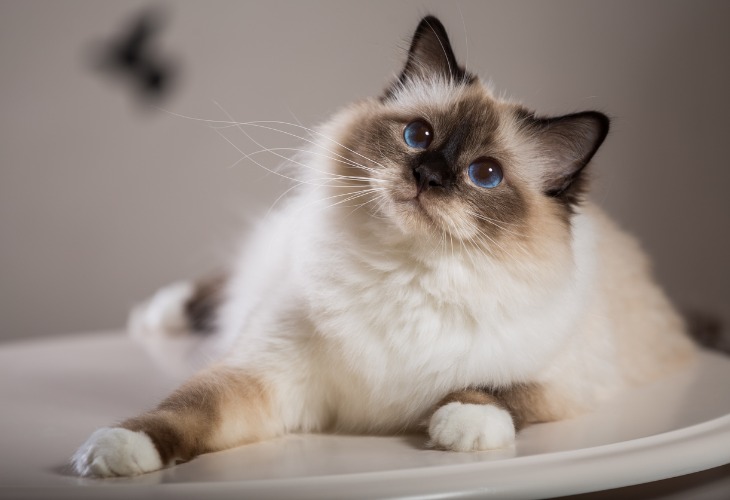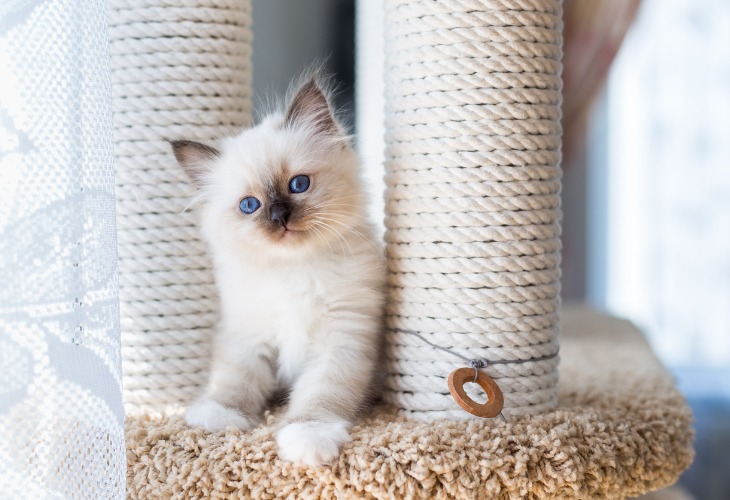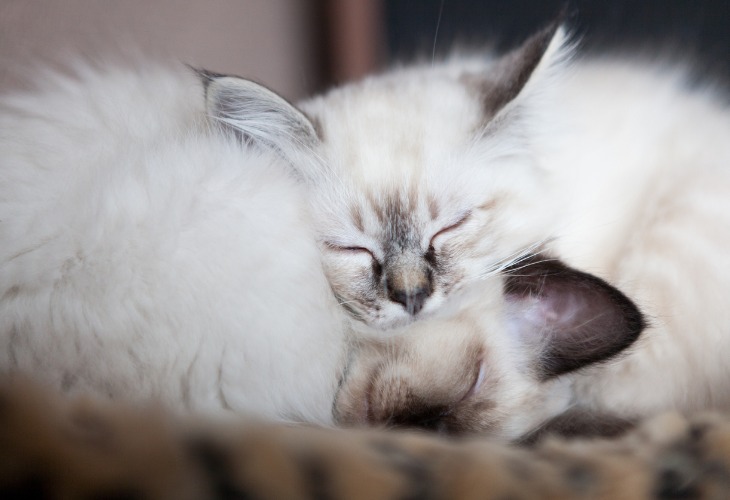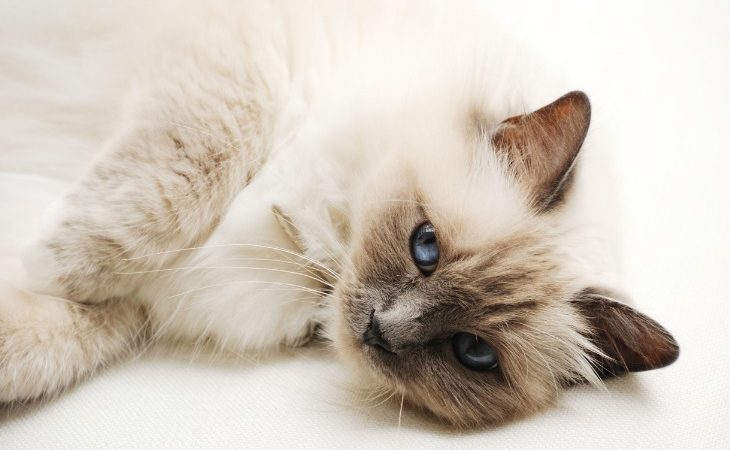Breed standard: CFA, FIFe, TICA, ACF, ACFA/CAA, CCA-AFC I Size: Medium I Average Lifespan: 15+ years I Personality: Calm, gentle, and affectionate I Coat: Medium-long I Origin: France.
The Birman, also known as the “Sacred Cat of Burma”, is a gentle, affectionate, sweet, and clever cat.
The Birman: myths versus reality
Myths and tales about the Birman’s origins
Many tales and legends speak about the Birman cat. However, the most popular tale about this cat breed was written by the novelist Marcelle Adam. In her story, she describes how this breed got its colors and unique markings.
Her story starts like this. Long ago in Burma (Myanmar), many years ago, an old priest and his white cat, named Sinh, lived in a temple dedicated to the golden goddess with sapphire eyes. One day, the temple was invaded and the priest was killed. Sinh jumped on his owner’s head and looked the idol of the goddess in the eyes. His own eyes became sapphire blue like those of the goddess and his fur was adorned with shades of gold except for his paws which were still placed on his deceased owner’s head, remaining white like the rest of his coat. A few days later, Sinh died of grief near his owner. The entire cat population of the kingdom then underwent the same physical transformation. Thus, the first Birmans were born.
According to legend, the white color of its paws symbolizes purity and devotion.
Another legend suggests a different theory about the origin of this cat breed. Birmans are said to have infiltrated the Temple of Lao-Tsun in Burma in order to steal a couple of cats. They are said to have been brought to France by an American billionaire in 1920.
Unfortunately, the male did not survive the trip, but the female, Sita, was pregnant and gave birth to a litter. This litter included the “Doll” of Madalpour, a female cat who actually existed. With this, legend is consistent with reality.
The origins of the “Sacred Cat of Burma”
The official history of the Birman is a little unclear, however, we do know that they came from England, Australia and Germany.
In the city of Nice, the first documented trace of the Birman was found and attributed to Madame Léotardi. The most widespread theory among breed historians is that the Birman was born in France in the 1920s from the crossing of a white-gloved Siamese and a Persian. This accidental cross is said to have been reproduced in the United States with an ungloved Siamese and resulted in the Himalayan, whose characteristics are very similar to those of the Birman.
In 1925, the Birman was officially recognized by the Cat Club de France and was given the name “Sacré de Birmanie” to avoid any confusion with the Burmese.
The breed almost went extinct during the Second World War, with only two of them left in Europe at the time. The two cats, Orloff and Xénia de Kaabaa, brought forth the litters that would establish the breed after the war. Following the hard work of the breeders, crossbreeding with other breeds of long-haired cats such as the Persian was carried out in order to recreate the morphology of the pre-war Birman.
In addition, the Birman is used to develop new breeds, like the Ragdoll.

The Birman’s personality
A personality of diverse origins
The various crosses performed on the Birman have all contributed the Birman that we know today. They also possess personality traits specific to each country from which they draw their history, such as the dramatic nature of the French, the loving nature of the Irish, the dignified nature of the English, the patience of the Germans and the adventurous spirit of the Australians. Throw in a touch of American ingenuity and you get the “Sacred Cat of Burma”.
The ideal cat?
The Birman is known for its calm nature. In addition, it is elegant and peaceful. When it comes to their meow, it is soft, similar to the sound of birds chirping. Somewhat of a cat-dog, this cat loves being around its owner and making itself useful. They are always there to accompany their owners as they go about their daily tasks. With a Birman, you will never feel lonely.
In addition to being exceptionally gentle, the Birman is an easy-going and obedient cat.
Friendly, kind, calm, and affectionate, this cat enjoys spending time with both humans and other animals. It is a playful cat that likes to be at the center of attention. In addition, its calm and tolerant personality makes it an excellent companion for families with children and other animals.
However, this cat does not enjoy being outdoors. They can live very happily in an apartment.

The physical characteristics of the Birman
General
The Birman is an impressive looking cat that stops growing around the age of three. It is a medium-long-haired cat with a heavy bone structure in relation to its size.
Like all colorpoint cats, the kittens are born white, and as they mature, their colors develop.
Head
Although its skull is medium-sized, its head is large, triangular, and has rounded edges. Its cheeks are full and its forehead is slightly rounded. Regarding its profile, it has a slightly concave change of direction at the eyes. The Birman has a Roman nose with no stop. The muzzle is medium long and broad. Its chin is strong.
When it comes to its eyes, they are large, roundish, and spread apart from each other. They are a deep blue color.
The Birman’s ears are medium-sized, almost as wide as they are tall, and spaced apart about the width of an ear. Their ends are rounded.
Body
This medium-sized cat has a long and powerful body with a straight and even back.
The neck is medium-sized and muscular. Its legs are moderately high and have a strong bone structure and muscles. When it comes to the paws, they are large and round, with five toes on the front paws and four toes on the back paws.
Its tail is medium-sized and proportional to its body.

Coat, color, and grooming
Coat
To begin with, its coat is medium-long and very silky. It is short on the head, gradually lengthening on the cheeks and becomes a ruff around the neck.
When it comes to the length of the Birman’s coat, it is long on the back and flanks. Its undercoat is sparse and light. On its belly, the hair can be slightly curly.
Colors
The Birman comes in a variety of different colors and patterns: blue, lilac, chocolate, cream, tortie, and many more. Its white paws are a unique characteristic of the breed.
Grooming the Birman
It is important to know the coat of the Birman changes with the seasons. In addition, it does not shed much. Brushing your cat once a week is enough to get rid of tangles and dead hairs.
The Birman at a glance
Size and weight: The Birman measures around 30 cm (≈ 11.8 in) and weighs between 4.5 and 7 kg (≈ 9.9 and 15.4 lbs).
Health: It is one of the healthiest and most robust cat breeds.
Is the Birman good with children? The Birman is a perfect cat for families with children and other pets because it is tolerant and calm.
How easy are Birmans to live with? The Birman is an exceptionally gentle, easy-going and obedient cat. Additionally, they are very attached to their owners and love to follow them around the house. In fact, some might say that the Birman is a bit clingy.

